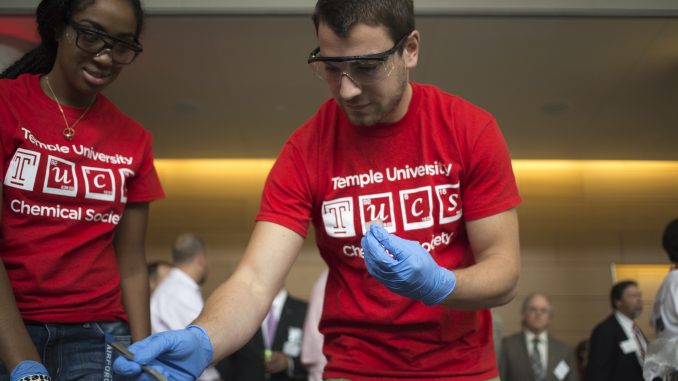
On Oct. 4, 1957, Soviet Russia sent into orbit a beach-ball-sized weather satellite named Sputnik I. The incident sparked the “space race” between Russia and America, as well as a national emphasis on science education amid fear of Soviet nuclear weapons. America was thought to be falling behind.
Temple responded to this question of U.S. technological superiority with the construction of three science buildings: Barton and Beury halls and the Biology Life Sciences building.
On Oct. 10, a week after the 57th anniversary of Sputnik’s launch, The Science Education and Research Center had its formal grand opening ceremony in its lobby. Faculty, alumni and students gathered to celebrate the growth of scientific research at Temple that administrators said is the purpose of the building.
“Half a century later today we are facing yet another Sputnik in the making,” Provost Hai-Lung Dai said in the first of a round of speeches at the meeting. “This time it is the economical competitiveness that is at stake. This new science facility will ensure the continuation of the renaissance in science that has been going on at Temple since the last decade.”
Dai concluded his speech by praising Visualize Temple, the master plan for growing campus facilities, which is set to be finalized by the end of the calendar year.
“Even before [the SERC] was completed, President Theobald had a vision to meet the challenges of the new millennium,” Dai said. “[Temple’s campus] must make a transformative change to assist its development in academics.”
President Theobald then took the stage, emphasizing that the building would help retain skilled faculty.
“The work done in this building will lead to the development of new ideas, new innovations, and potential new technologies,” Theobald said.
Lt. Gov. Jim Cawley also made an appearance at the grand opening to show both his and Gov. Tom Corbett’s support.
“It was important for [Corbett] and I to make this financial commitment,” Cawley said in an interview. “It’s not Tom Corbett’s money. It’s not Jim Cawley’s money. It’s all of our money.This is a true investment for the future and it’s something that I think is going to reap huge benefits.”
U.S. Rep. Chaka Fattah, a former Temple trustee whose district includes parts of Main Campus, said opening the SERC “really positions Temple to be one of the major leaders in this innovation ecosystem in town.”
“This puts Temple really at the cutting edge now,” Fattah said. “I think it will attract professors and students from around the world and literally around the corner.”
Patrick O’Connor, chairman of Temple’s Board of Trustees, commented on the possibilities the new building brings to Temple students. “The great building represents a quantum leap for Temple in the science and technology field,” O’Connor said in a speech.
O’Connor also made a point to thank the Commonwealth of Pennsylvania, namely Cawley and Corbett, for providing a significant capital grant to enable the building’s construction.
“It is because of their support that Temple University now hosts one of the finest science facilities in the East Coast,” O’Connor said.
Some faculty expressed excitement toward the opening.
“I think Temple’s growing up,” said Dr. Eric Borguet, a chemistry professor. “I think this is the kind of building you will see in a major university. I think it’s the start of a new beginning.”
Dr. S. Blair Hedges, a new biology professor at Temple, said the SERC is the main reason he left teaching at Pennsylvania State University. “Really nice facilities can catalyze good research in science,” Hedges said. “They can attract new faculty who might not otherwise come to an old building. As a consequence it’s certainly good for Temple and for science.”
Nathalie Swann can be reached at nathalie.swann@temple.edu
John Moritz contributed reporting.


Be the first to comment